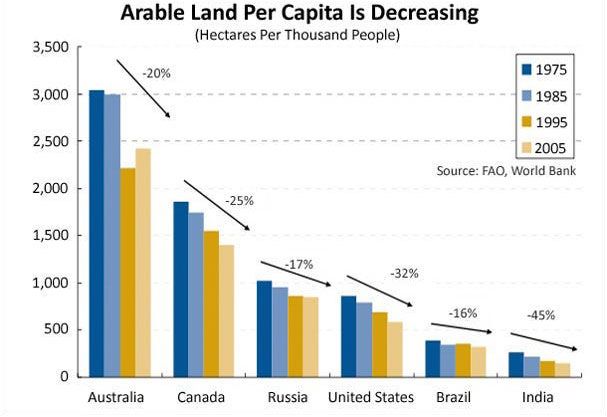Are smart farms the future of agriculture?


There is a lot of buzz these days around how the industrial IoT and big data are changing industries across the board. The agriculture industry is no exception. The farming sector has had to find innovative and novel ways to keep up with skyrocketing demand, fuelled by a rapidly expanding global population. It has had to embrace technology in order to maximise efficiency and minimize costs. Read ahead to find out more about the digital transformation that agriculture is undergoing. In this article, we explain how a data-driven approach based on IoT technology and cloud computing is the future of agriculture.
The food problem
Global population is set to hit the 10 billion mark by the year 2050! Take a second to wrap your head around that number and let it sink in! The UN estimates that we will need to double our food production by 2050, in order to be able to feed that many people.
But that is going to be incredibly challenging. It is actually getting harder, not easier, for us to grow food. As things stand, cities are expanding at rates previously undreamt of and hundreds of millions of people are escaping poverty each year. Farmers around the world have to contend with a seemingly impossible set of challenges:
Upward social mobility
Hundreds of millions of people are escaping poverty every year and entering the middle class. This trend is especially conspicuous in rapidly growing economies such as China and India. This is, by no means, a bad thing. However, this means that the number of calories consumed by the average individual has increased tremendously. While upward social mobility is not something we need to worry about, it does place a tremendous strain on global food production.
Decline in arable land
According to some estimates, the planet has lost about 1/3rd of it’s arable land in the last 40 years. As things stand, cities are expanding at a rate never witnessed before. This has obviously come at the cost of land that could potentially be used for agriculture.
Deforestation is another major culprit - Here’s a scary statistic -
It is estimated that we lose about 40 football fields worth of rainforest every minute! This severely impacts soil quality and causes degradation. Erosion and degradation further complicate our ability to meet the burgeoning global demand for food.

Limited resources
Water scarcity and shortage of other essential resources is another major challenge. Farmers around the world are battling severe supply-line crunches and shortages which can have a devastating impact on their lives and on the economy.
A move towards data-driven agriculture
So, we have to find a way to feed our ever-growing population. But obviously, there are other variables at play. While we expand our ability to produce more food, we need to make sure that this expansion doesn’t come at the cost of ecological catastrophe. In other words, we need to make sure that the growth is sustainable.
This points to one very obvious fact - farming the way we have farmed for thousands of years can’t feed the world today. Here’s where technology comes in. Producing more food comes down to two things - increasing efficiency and cutting down on waste. And today, we have the data processing abilities and internet coverage to make it happen. In keeping with Moore’s law, we now have sensors that are inexpensive enough to be deployed in large numbers . Moreover, the extremely widespread penetration of handheld computing devices (such as smartphones) and mobile internet also offers us many opportunities to integrate modern ICT (information and communication technologies) into agriculture. IoT technology offers us some promising solutions around some of these constraints.
More specifically, there have been some recent developments that have made it possible for us to connect farms to the internet - In the last few years, we have made rapid strides towards making inexpensive, low-power sensors, capable of driving this new agricultural revolution. Digitizing agricultural operations requires a lot of sensors to be deployed; Moreover, these sensors can’t be battery powered. Batteries require maintenance and need to be replaced, which defeats the central credo of data-driven agriculture (i.e. saving time and effort). Thankfully, today, we have ways around this. We are now able to make self-powered sensors that are able to function autonomously, without batteries. These batteryless sensors are able to harvest ambient energy (radio-frequency waves, piezoelectric energy etc) to meet their power requirements.
Read our “What is Energy Harvesting?” piece to know more about energy harvesting technologies and how they are empowering the IoT revolution.
In the past, the costs associated with deploying a large number of sensors in a farming operation were prohibitive and made IoT based farming impractical for all but the most powerful players. Today, with batteryless, nano-power MCUs like ONiO.zero and ubiquitous cellular data, smart farming is no longer a pipe dream.
Data-driven agriculture is a fast-growing industry and is poised to continue on its upward trajectory. Big players in several affiliated industries have taken note of the tremendous market opportunity that data-driven farming presents. The global smart agriculture market is expected to hit a whopping 17.9 billion by 2025!
What is smart farming?
Smart farming is a fairly recent concept that essentially means using information and communication technologies (ICT) to increase the efficiency of a farming operation and reduce the amount of human labour and wastage involved in the farming process. This is just like a smart city or a smart home harnessing the power of data and cloud computing in order to make for a more responsive, immersive and efficient user-experience. In the case of smart farming, huge amounts of data are harnessed to gain unique insights which can be applied to increasing the efficiency of farming practices.
Modern farmers have a plethora of state-of-the-art technologies at their disposal. Farmers today can deploy a variety of sensors in their field. Moreover other technological tools such as connectivity and data analytics are also much more accessible today. All of this essentially comes down to our ability to collect, process and share data better than ever before. The internet of things is essentially this - we use things (e.g. sensors) to collect specific information and then, we use the internet to share this information and analyse it for patterns. This allows us to make better decisions and maximise production.
There is a prevalent misconception that this kind of a data-driven approach is only suitable for large-scale farming operations. Nothing could be further from the truth - in reality however, IoT driven agriculture can offer a huge leg-up to smallholder farmers and family-farming operations. They encourage niches like organic farming and growing specific varieties of crops. Smaller operations stand to benefit hugely from the sort of optimisation that smart farming brings.
There are any number of applications that IoT (Internet of Things) devices could have in agriculture. But all of them rely on the basic premise of collecting specific data in order to maximise efficiency and minimise waste. For instance, moisture sensors can help track the soil moisture content in different parts of the field accurately and help the farmer make strategic decisions about allocating water to different parts of the farm. In the long run, this would allow the farmer to cut down on his water usage and would therefore translate to significant savings.
How does IoT based smart farming work?
Most “smartfarms” essentially use a system that is built to monitor the crop field by using a variety of sensors (light, humidity, temperature, moisture etc). In many cases, the irrigation system is also automated and controlled by the monitoring system. The farmer can then monitor the conditions of his field, anytime, on his smartphone perhaps. Ideally, this could offer him all the data he would need in order to make strategic decisions pertaining to the farm.
Typically, IoT based smart farming follows a raw blueprint of harnessing data and analyzing it to optimise the farming process, in a repetitive cycle that looks something like this -
1. Observation
Sensors placed in various places pick up various kinds of data from the crops, animals, soil or air.
2. Diagnostics
The data is then fed to a cloud-based platform which has predefined rules and models. The cloud-based IoT system crunches the data and comes up with actionable intelligence that can be used to correct any deficiencies or shortcomings in the farming process.
3. Decisions and action
After identifying the issues that need to be set right, the execution wing of the system takes over. For instance, machine-learning components of the system could use the intelligence gathered to decide where and when location-specific interventions are necessary.
4. Repeat
After the farmer evaluates the suggestions and implements them, the whole cycle starts all over again.
What are the advantages of smart farming?
Here are some pretty key advantages that smart farming brings to the table.
1. More data = better farms
Having access to tons of data and sophisticated analytics could offer a farmer all sorts of unintended advantages. Analytics can offer a farmer invaluable insights into the health of his enterprise and allow for better monitoring of equipment efficiency, staff performance, etc.
2. Lower production risks, lower waste
Smart farming allows us to make more reliable forecasts on output/production. This is huge because it helps farm owners plan product distribution and estimate crop yield - If you can make a reasonable prediction as to how much crop you are going to harvest, you will find a way to make sure your product won’t lie around rotting.
3. More economical
Data-driven agriculture offers a high level of control. All sorts of tiny variables can be tweaked, with a high level of precision. This translates to higher yields and therefore, higher savings. Moreover, anomalies can be detected early with smart farming. This translates to a significantly lower risk of losing an entire yield.
4. Streamline and automate tasks
Using smart technology allows farm owners to automate multiple processes across various stages of production, like pest control and irrigation.
5. Better crop quality, higher volumes
Data-driven farming allows the farmer to have strict control over the farming process and allows for high standards of quality to be maintained. Employing smart technology also translates to higher yields because of improved crop health.
6. Better for the environment
IoT based smart farming also brings a host of environmental benefits to the table. A sophisticated data-driven approach to agriculture can help us economise on water usage. Moreover, it also helps farmers minimize the amount of pesticides/fertilizers used.
Applications of big-data / IoT technology in agriculture
Precision farming
Precision farming or precision agriculture is an umbrella term that refers to anything that makes farming more controlled and deliberate. Let’s look at it this way - plant A and plant B located at different parts of a farm will obviously have very different requirements. Precision farming essentially means using technology to give an individual plant (or animal) exactly what it needs, with extreme precision.
Traditionally, decisions were made for an entire farm or at least, over a large part of a farm. Precision agriculture allows us to customise decisions per square meter of the farm or even down to each plant! Precision farming allows the farmer to gain deep insights into hundreds of variables and precisely measure tiny variations. This allows the farmer to enjoy better yields and use his resources most optimally.
Precision agriculture is probably the most widely known application of IoT in the agricultural space.
Drones
Agricultural drones are a great example of a very traditional industry wholeheartedly embracing technology. Today, the agriculture sector is one of the largest users of drones. Drones can perform a wide range of functions on a farm, from assessing the health of crops to planting seeds.
Drones offer farmers a bird’s-eye perspective of their land. This allows them to monitor irrigation and crop health and watch out for infestations and technical issues. Moreover, the farmer can set the drones up to survey the field periodically and can examine changes in his crop over a period of time, using pictures. This could allow the farmer to identify “problem areas”, if any and through that, improve his crop management and production.
Drones provide farmers with a wide array of metrics. Plant health indices, yield prediction, plant height measurement, water mapping, stockpile measuring, drainage mapping, etc are just a few of the metrics that a farmer can use drones to obtain.
The farmer can customise the type of data he gets from the drones. He can select which parts of his field he wants surveyed, how regularly and also select an altitude or camera resolution. This makes an immeasurable difference to a farmer’s life.
Livestock farming
Just like precision agriculture, sensors can also be used to monitor individual animals and use the data to cater to their needs with a high degree of precision. Using sensors can allow the farmer to understand the specific needs of individual animals and tailor their nutrition/healthcare accordingly. Technology can also help identify sick animals and separate them from the herd. This allows the farmer to maintain good herd health and lowers the incidence of outbreaks.
IoT technology is especially useful for those who own large ranches or cattle farms. Farm owners can now use IoT devices to remotely monitor the locations of their livestock. They can also have access to sophisticated metrics on the health of their cattle, all on their smartphone.
Smart greenhouses
Greenhouse farming is used to obtain high yields of fruits, vegetables, flowers etc by controlling the microclimate in which crops are grown. Traditionally, the environmental parameters are controlled manually, which results in losses (production loss and energy loss). This also translates to a higher labour cost.
Using IoT-powered smart greenhouses can vastly reduce or in some cases, even eliminate the need for manual intervention. Smart greenhouses are equipped with sensors to capture various kinds of environmental parameters and deliver this information continuously to the cloud. This is where smart greenhouses really shine over their traditional counterparts. Vast amounts of data are processed in an IoT platform, where this raw data is turned into usable analytics. The farmer can now use this intelligence to care for his plants in a highly customised and sophisticated way. Having 24/7 access to data means that traditional “problem areas” and
Lighting, irrigation, spraying etc can be completely automated, cutting down on labour costs. Moreover, the data stored on the cloud based platform can be used to make predictive models that can help with assessing disease risk. So, in a nutshell, a smart greenhouse allows a farmer to unlock deep insights into his crops by harnessing the power of the cloud. This directly improves yield rates and makes for greater efficiency in the use of resources and chemicals.
Smart greenhouses are forecasted to represent a market value of more than $1 billion by 2024 and are definitely a major trend to follow in agriculture.
A third green revolution
Smart farming and IoT-driven agriculture are not merely passing fads in agriculture. The signs point to the beginning of a “third green revolution”, that is going to permanently alter the way we produce food.
Smart farming forecasts a future where our food will be grown with minimal pesticide and fertilizer use. The internet of things will also improve food traceability, which will have a ripple effect on food safety. More importantly, the environmental benefits of smart farming are extremely encouraging - IoT driven agriculture can help us economise on water and make sure we are ecological in our bid to feed a massive global population.
In conclusion
Collecting and sharing data has never been easier. Today our technological capabilities make it possible for us to glean unprecedented insights into the many aspects of food production. IoT technology makes it possible for us to use farm data to make smarter decisions and therefore, improve yields sustainably.
The many benefits of data-driven farming will only compound as more and more farms get connected to the internet. The intelligence gathered from the collected data has the power to enable further innovations, potentially setting off a positive chain reaction. This might be a hopeful assessment of the future, but with the internet of things growing the way it is, it is certainly not wishful.













